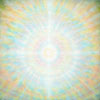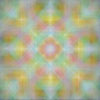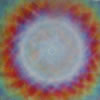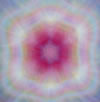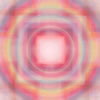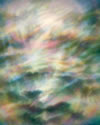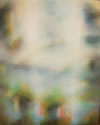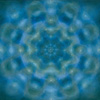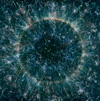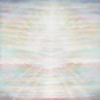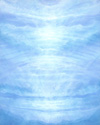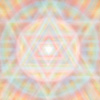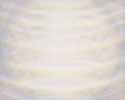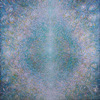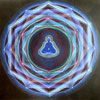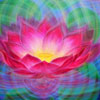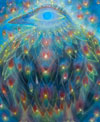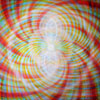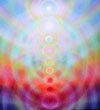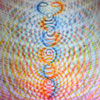Thoughts by Wolfgang Hannen
Om mani padme hum (or as the Tibetans pronounce it: Om mani päme hung) „Praise the jewel in the heart of the lotus“
A speech by Anna Teichler:
The artist Wolfgang Hannen, whose work we can experience here, has dealt a lot with the philosophy of Buddhism in recent years, especially with the spiritual tantra teachings of Tibetan Buddhism and Zen Buddhism.
Furthermore, the work of the Swiss Jean Gebser found a great echo in his soul.
I would now like to explain a few terms that came up again and again in the creation process of the work.
There is the term „MANDALA“.
The word comes from Sanskrit and simply means „circle“.
A Tibetan mandala always has a center. In this center sits a deity. This „inner core“ always lies within a square, the „palace of inner being“. He is surrounded by one or more circles, each of which symbolizes a particular level of consciousness.
The mandala is a meditation object and at the same time the seat of the deity. There is a way into the interior, there are guards at certain gates and, spatially speaking, the goal is always the center. The meditator has to cleanse himself inwardly in the various forms of consciousness, change and surrender to dissolution, until he is finally allowed to enter the temple: the interior of the lotus. Inside is the jewel with its „vajra lightvajra light“.
OM MANI PADME HUM. - At the end the meditator identifies himself with the deity there and unites with the wisdom of the deity. It is similar to Augustine, who said: „My soul is restless until my God rests in you.“
1
Wolfgang Hannen has repeatedly emphasized the “mandala process” that he experienced while creating his work. He kept saying: "My pictures should bring the level of being, the vajra light, to resonate in us.”
What is the "Vajra Light"? (again a word from Tibetan Buddhism)
It is the light of clear, brilliant, jewel-like consciousness, the light of pure awareness, of being present. The vajra is the indestructible, the eternal being in being, reality.
So the question was always present while painting, whether the picture in its order or in its effect could indicate this vajra state.
For him, images are tools, just as a mantra or a yantra can be and there is a search in the artist to express this light. He is only satisfied when it is THERE, when it comes to sound through the perception of the picture, in his own experience, in his own being, in contact with his own divine core. He then tries to increase the images until this light can appear or can be sensed.
In this context I now have to bring the cultural anthropologist Jean Gebser into play. In his work “Origin and Presence” he dealt with the development of human consciousness and divided human consciousness into different structures. There are the archaic, the magical, the mythical and the mental structure of consciousness. According to him, we are currently in the mutation to the so-called integral consciousness, whose characteristic is the integration of all previous structures of consciousness, and beyond that the appearance of the diaphane.
Statement: "The translucent (diaphane or transparency) is the manifestation (epiphany) of the spiritual.”
2
Gebser says elsewhere: “It is a matter of making transparent what is hidden in the world and behind and from it, of making transparent our origins, our entire human past and the present, which already contains the future; for the future and not just yesterday and today also form and determine us. It is about making the whole person transparent.“
Like the Buddhists, Gebser also speaks of presence.
Presence is a holistic awareness and is characterized by a positive lack of intent and premeditation.
I mention Gebser's thoughts because I believe that the works of Wolfgang Hannen make this process of making transparent for us as viewers tangible. * I would like to share something about the creation process of the light energy fields. In some pictures, Wolfgang starts with earthly structures, e.g. cloud formations or light landscapes. Other levels are placed on top of these structures. The next level would be “weaving into it” (I call it that because this painting process of the super-thin glazed layers of paint is also equivalent to weaving), what he calls it: rainbow light. It is like a fanning out of an immaterial light perceived by him into the bright colors of the perceptible world. He lets himself be guided by observing nature on his daily walks.
For example: The “purple light” of the snow fields during the Christmas season. Imagine: Sunlight at dusk, the sun is no longer there ... There is a reflection on the white light ... and at the same time a purple vibration can be experienced by the opened heart ... purple.
3
His soul conveys to him in the observation of nature, or in the experience of nature, in what particularly lights up the hint, or the help, how the picture is to be further formulated. He does not formulate it in words, but in areas of color or structures, lines, limited areas, certain gestures. He is inspired e.g. by certain tree-top gestures, or how the light spreads on the water or an ice surface. This then gives him the hint that a certain color wants to spread. He then follows that. Or the silence of a bird's flight refers him to the moment of silence.
So everything where his soul lights up, where his soul becomes bright, where something is really experienced, something is communicated that belongs to this mandala process. This can also be a conversation where a certain connection becomes clear. In this process the image and himself become a membrane: inside - outside - inside - outside (like outside so inside, like inside so outside).
In this way “Purusha” and “Awakening” came into being.
Then there is the artist's approach of meditatively concentrating on a certain quality. E.g. on the energy of his root chakra. He perceives the energy by concentrating on it and then intuitively draws a structure that results from this inner perception. This can be a starting point, so that e.g. the circle and the square become an impulse to act, which he then pursues in a drawing. That is, so to speak, the entry into this mandala process, with which it then goes into resonance in the encounter with natural phenomena.
This is how "Gabriel" and "Root Chakra" came about.
A third source of inspiration is the conscious contact with the spirituality that he encounters in other cultures. E.g. Islamic art, ornamentation and spiritual architecture in Andalusia. Feeling the essence behind the appearances, what speaks in his soul when there
4
is a square with an octagon above it and a dome above it, like the Mesquita in Cordoba, that great mosque.
His soul receives nourishment through meditation, the experiences of nature, conversations, contents that blow him over. It is “reflected” in painting, it becomes concrete. It becomes design, manifest, sensually present.
His pictures are not personal. They are not psychograms. They have a language, a power, an inner signature that can reach the soul of the beholder when it opens up to them.
These signatures of light are ultimately invitations for the artist to go on their own journey.
What wants to show itself in you is your access to what speaks in you (or not).
Everyone has their own gate, another door, another key, their own possibility to come into contact with being, the jewel in the heart of the lotus. The contemplation in itself is a soul / spiritual process, otherwise one would not perceive anything.
At the moment of viewing: How do you get into resonance?
Is there any activity of the mind, your mental consciousness? An analysis: “Ah! Circle, diagonal etc.?
Or do you immerse yourself in the effect of the colors, in the mystical space?
Can you feel your etheric body while looking at these light energy images?
Can you do that at the same time?
Have fun!
Anna Teichler Ceramicist, painter, art teacher and art therapist at the opening of the exhibition at the Steinreich Gallery - Bremen - February 2011


